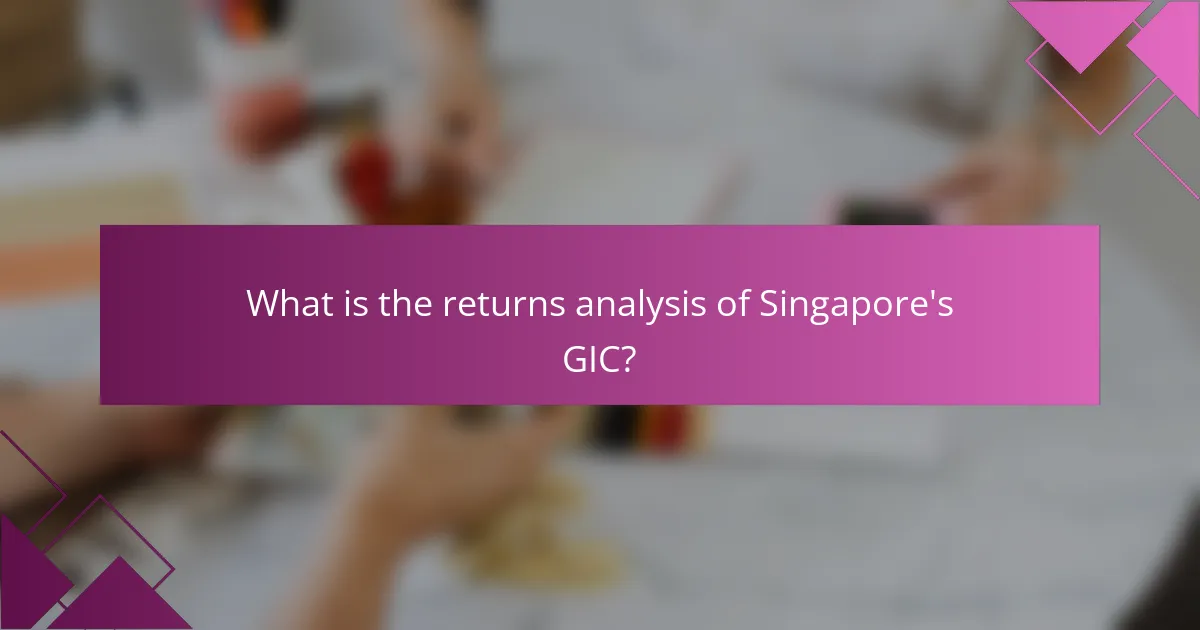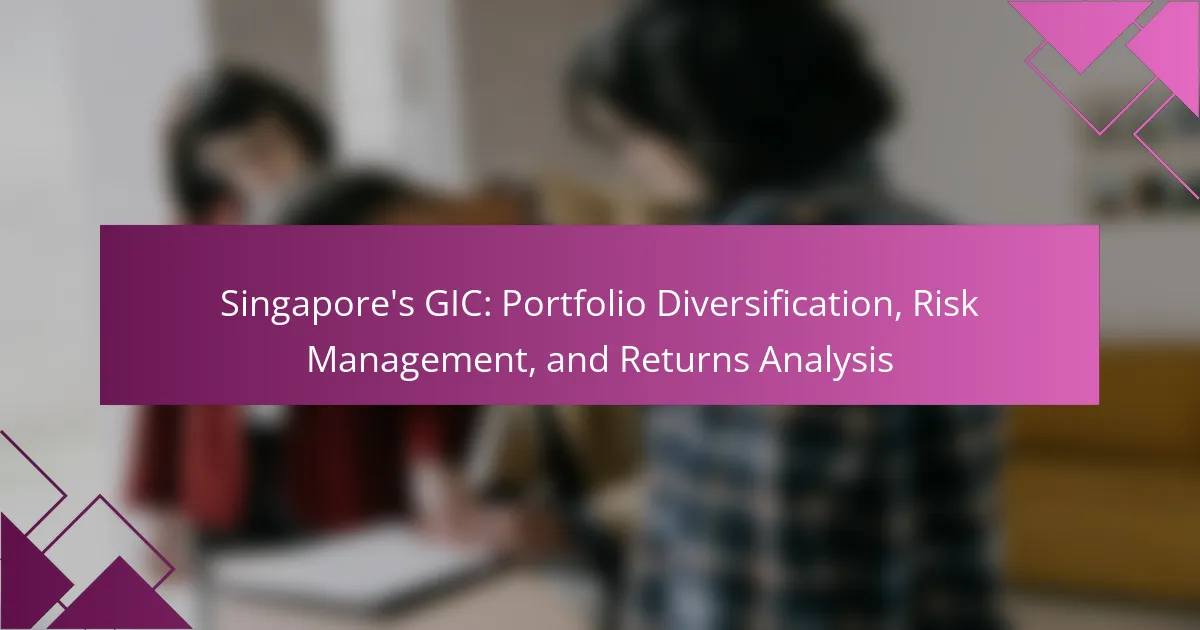
What is Singapore’s GIC?
Singapore’s GIC is a sovereign wealth fund established in 1981. It manages Singapore’s foreign reserves. GIC aims to preserve and enhance the international purchasing power of the reserves. The fund invests in a diversified portfolio across various asset classes. These include equities, fixed income, real estate, and private equity. GIC follows a long-term investment strategy. It focuses on risk management and sustainable returns. As of 2023, GIC has over $100 billion in assets under management.
How was Singapore’s GIC established?
Singapore’s Government Investment Corporation (GIC) was established in 1981. It was created to manage Singapore’s foreign reserves. The formation aimed to preserve and enhance the country’s wealth for future generations. GIC was initiated by the Ministry of Finance of Singapore. The organization focuses on long-term investment strategies. It invests in a diverse range of asset classes globally. GIC operates independently and is governed by a board of directors. Its establishment reflects Singapore’s proactive approach to financial management and economic stability.
What are the foundational principles of Singapore’s GIC?
The foundational principles of Singapore’s Government Investment Corporation (GIC) include long-term investment, prudent risk management, and active portfolio diversification. GIC aims to achieve sustainable returns over the long term. It focuses on a diversified investment approach across various asset classes and geographies. This strategy helps mitigate risks associated with market volatility. GIC employs rigorous research and analysis to make informed investment decisions. The organization emphasizes transparency and accountability in its operations. Additionally, GIC aligns its investments with Singapore’s long-term financial goals. These principles ensure the preservation and enhancement of Singapore’s reserves for future generations.
What role does Singapore’s GIC play in the national economy?
Singapore’s GIC plays a crucial role in the national economy by managing the country’s foreign reserves. It invests these reserves globally to generate sustainable returns for Singapore. GIC’s investment strategy focuses on diversification across asset classes and geographies. This approach helps mitigate risks associated with economic fluctuations. In the fiscal year 2022, GIC reported a 6.0% nominal rate of return, contributing to the nation’s wealth. The returns support government spending and social programs. GIC also enhances Singapore’s financial stability by providing a buffer during economic downturns. Overall, GIC’s management of assets strengthens the national economy.
What are the primary functions of Singapore’s GIC?
The primary functions of Singapore’s GIC include managing the country’s foreign reserves and investing in a diversified portfolio. GIC aims to achieve good long-term returns to support Singapore’s financial needs. It employs a range of investment strategies across various asset classes. The entity focuses on risk management to protect capital and ensure sustainable growth. GIC also conducts research and analysis to inform investment decisions. This approach allows GIC to adapt to changing market conditions. Additionally, GIC plays a role in contributing to Singapore’s economic stability. Its investments support the growth of both local and global markets.
How does Singapore’s GIC manage its investment portfolio?
Singapore’s GIC manages its investment portfolio through a diversified approach across various asset classes. This includes equities, fixed income, real estate, and alternative investments. GIC employs a long-term investment strategy, focusing on sustainable returns over decades. The organization utilizes a rigorous risk management framework to assess and mitigate potential risks. This framework incorporates quantitative models and scenario analysis to guide investment decisions. GIC also emphasizes global diversification, investing in markets worldwide to reduce concentration risk. Additionally, the organization continuously monitors market trends and adjusts its portfolio accordingly. GIC’s disciplined investment process is designed to achieve a target real rate of return, contributing to Singapore’s financial reserves.
What strategies does Singapore’s GIC employ for risk management?
Singapore’s GIC employs several strategies for risk management. These strategies include diversification across asset classes and geographical regions. GIC utilizes a long-term investment horizon to mitigate short-term volatility. The organization conducts rigorous stress testing to evaluate potential risks. Additionally, GIC implements a disciplined asset allocation framework. This framework adjusts based on market conditions and economic outlooks. GIC also emphasizes active risk management practices. These practices involve continuous monitoring of portfolio risks and exposures.
What is the significance of portfolio diversification in Singapore’s GIC?
Portfolio diversification in Singapore’s GIC is significant for risk management and enhancing returns. It allows the GIC to spread investments across various asset classes and geographies. This strategy reduces exposure to any single investment’s volatility. By diversifying, GIC aims to achieve a more stable overall performance. Historical data shows that diversified portfolios typically yield better risk-adjusted returns. This approach aligns with GIC’s long-term investment horizon and financial goals. Additionally, diversification helps mitigate potential losses during market downturns. Overall, it is a fundamental strategy for maintaining financial resilience.
How does portfolio diversification benefit Singapore’s GIC?
Portfolio diversification benefits Singapore’s GIC by reducing risk and enhancing returns. Diversification allows GIC to invest in a variety of asset classes, such as equities, bonds, and real estate. This strategy mitigates the impact of poor performance in any single investment. For instance, during market downturns, losses in one sector can be offset by gains in another. According to GIC’s annual report, a diversified portfolio has historically led to more stable returns over time. This stability is crucial for long-term growth and meeting the financial needs of Singapore. Thus, portfolio diversification is a key component of GIC’s investment strategy.
What are the key asset classes included in Singapore’s GIC’s portfolio?
The key asset classes included in Singapore’s GIC’s portfolio are equities, fixed income, real estate, and alternative investments. Equities represent a significant portion of the portfolio, providing growth potential. Fixed income assets offer stability and income generation. Real estate investments contribute to diversification and potential appreciation. Alternative investments include private equity and hedge funds, enhancing overall returns. GIC strategically allocates across these classes to manage risk and optimize returns.

How does Singapore’s GIC approach risk management?
Singapore’s GIC approaches risk management through a comprehensive framework that emphasizes diversification and strategic asset allocation. The organization employs a multi-dimensional risk assessment process. This process includes market risk, credit risk, and operational risk evaluations. GIC’s investment strategy focuses on long-term returns while mitigating potential losses. It utilizes sophisticated modeling techniques to predict and manage risks. The GIC also conducts stress testing to evaluate portfolio resilience under various scenarios. Regular reviews and adjustments ensure alignment with changing market conditions. These practices collectively enhance GIC’s ability to safeguard its assets effectively.
What risk management frameworks does Singapore’s GIC utilize?
Singapore’s GIC utilizes several risk management frameworks. These include the Enterprise Risk Management (ERM) framework. This framework helps identify, assess, and manage risks across the organization. GIC also employs a robust stress testing framework. This framework evaluates the impact of extreme market conditions on its portfolio. Additionally, GIC integrates a risk appetite framework. This framework aligns risk-taking with its strategic objectives. GIC’s approach is supported by quantitative models and qualitative assessments. These methods ensure comprehensive risk evaluation. The frameworks are designed to adapt to changing market dynamics.
How does Singapore’s GIC assess and mitigate investment risks?
Singapore’s GIC assesses and mitigates investment risks through a comprehensive risk management framework. This framework includes rigorous analysis of macroeconomic factors, market conditions, and asset-specific risks. GIC employs quantitative models to forecast potential risks and returns. It diversifies its portfolio across various asset classes and geographies to reduce exposure to any single risk. Regular stress testing is conducted to evaluate how investments might perform under adverse conditions. GIC also engages in scenario analysis to anticipate potential market shifts. These strategies are supported by a team of experienced risk professionals who monitor investments continuously. By employing these methods, GIC aims to achieve long-term, sustainable returns while managing risks effectively.
What are the key performance indicators for risk management at Singapore’s GIC?
The key performance indicators for risk management at Singapore’s GIC include Value at Risk (VaR), stress testing results, and portfolio diversification metrics. VaR measures potential losses in investment portfolios over a defined period. Stress testing evaluates how portfolios perform under extreme market conditions. Diversification metrics assess the distribution of investments across asset classes and geographies. These indicators help GIC manage exposure to market fluctuations and optimize risk-adjusted returns. The use of these metrics is essential for maintaining financial stability and achieving long-term investment objectives.
Why is risk management critical for Singapore’s GIC?
Risk management is critical for Singapore’s GIC to safeguard its assets and ensure sustainable returns. The Government of Singapore Investment Corporation (GIC) manages Singapore’s foreign reserves. It invests in a diversified portfolio across various asset classes globally. Effective risk management helps identify, assess, and mitigate potential financial losses. The GIC’s strategy includes managing market, credit, and liquidity risks. In 2022, GIC reported a 5.4% nominal rate of return, highlighting the importance of effective risk strategies. By employing risk management practices, GIC can maintain stability and achieve long-term growth.
How does effective risk management impact returns for Singapore’s GIC?
Effective risk management enhances returns for Singapore’s GIC by minimizing potential losses. It allows for better allocation of assets across various investment classes. This strategy reduces volatility in the portfolio. By identifying and mitigating risks, GIC can capitalize on market opportunities. Historical performance shows that disciplined risk management leads to more consistent returns. For instance, GIC’s diversified portfolio has outperformed benchmarks during economic downturns. This approach safeguards capital while pursuing growth. Consequently, effective risk management is crucial for achieving long-term financial objectives.
What lessons can be learned from Singapore’s GIC’s risk management practices?
Singapore’s GIC demonstrates effective risk management practices that offer valuable lessons. Firstly, GIC emphasizes diversification across asset classes and geographies. This reduces exposure to volatility in any single market. Secondly, GIC employs a long-term investment horizon, allowing for market fluctuations to stabilize over time. Thirdly, GIC integrates robust quantitative analysis to assess risks comprehensively. This data-driven approach informs strategic decisions. Additionally, GIC maintains a disciplined investment process, prioritizing risk-adjusted returns. Lastly, GIC’s proactive monitoring and adaptation to changing market conditions enhance resilience. These practices collectively contribute to GIC’s reputation as a leading sovereign wealth fund.

What is the returns analysis of Singapore’s GIC?
Singapore’s GIC has consistently delivered strong returns over the long term. The average annualized return since its inception in 1981 is approximately 6.0% to 7.0%. This performance is measured after inflation, showcasing GIC’s effective management of its investment portfolio. GIC invests across multiple asset classes globally, including equities, fixed income, and real estate. This diversification helps mitigate risks and enhance overall returns. Additionally, GIC’s investment strategy focuses on long-term value creation and sustainability. The organization employs rigorous research and analysis to identify high-potential investment opportunities. This approach has contributed to its resilience during economic fluctuations.
How are returns measured at Singapore’s GIC?
Returns at Singapore’s GIC are measured using a combination of absolute and relative performance metrics. The absolute return reflects the total investment gains or losses over a specific period. Relative performance is assessed against relevant benchmarks, such as global market indices.
GIC employs a long-term investment horizon, typically evaluating returns over a 20-year period. This approach allows for a comprehensive understanding of performance trends. GIC also considers risk-adjusted returns, which account for the level of risk taken to achieve those returns.
Performance is reported annually, providing transparency and accountability. The organization aims to achieve a real rate of return above inflation over the long term. This strategy supports GIC’s mandate to preserve and enhance the value of Singapore’s foreign reserves.
What benchmarks are used for performance comparison?
Common benchmarks for performance comparison include the MSCI World Index and the FTSE All-World Index. These indices represent a broad range of global equities. They serve as standards to evaluate investment performance. The Singapore GIC often uses these benchmarks to assess its portfolio returns. Performance is measured against these indices to determine relative success. Historical data shows that these benchmarks reflect market trends effectively. They provide context for understanding GIC’s investment strategies and risk management. Comparisons against these benchmarks help identify areas for improvement.
How does Singapore’s GIC report its investment returns?
Singapore’s GIC reports its investment returns through a comprehensive annual report. This report details the performance of its portfolio across various asset classes. It includes key metrics such as total returns, benchmark comparisons, and risk assessments. GIC employs a long-term investment horizon, typically reporting returns over a 20-year period. The organization emphasizes transparency and accountability in its reporting practices. Additionally, GIC’s returns are benchmarked against global market indices to provide context. The annual report is publicly available, ensuring stakeholders can access detailed financial information. This practice reinforces GIC’s commitment to clear communication regarding its investment performance.
What factors influence the returns generated by Singapore’s GIC?
The returns generated by Singapore’s Government Investment Corporation (GIC) are influenced by several key factors. These factors include global economic conditions, interest rates, and market performance. The GIC’s investment strategy emphasizes diversification across asset classes and geographic regions. This diversification helps mitigate risks associated with specific markets or sectors. Additionally, currency fluctuations can impact the returns of overseas investments. The GIC also considers inflation rates, as they affect the real value of returns. Finally, the performance of underlying assets within the portfolio directly influences overall returns. Historical data shows that GIC has achieved an annualized return of around 6% over the long term, reflecting its strategic management of these factors.
How do market conditions affect Singapore’s GIC’s investment performance?
Market conditions significantly impact Singapore’s GIC’s investment performance. Fluctuations in global economic indicators influence asset valuations. For instance, during economic downturns, equity markets typically decline, affecting GIC’s equity investments. Conversely, favorable market conditions can enhance returns on investments. Interest rates also play a crucial role; lower rates can boost borrowing and spending, positively impacting GIC’s fixed-income assets. Additionally, geopolitical events can create volatility, leading to increased risk in GIC’s portfolio. Historical data shows that GIC’s performance correlates with market trends, reflecting its adaptive investment strategies. Thus, understanding market conditions is essential for assessing GIC’s investment outcomes.
What is the historical performance of Singapore’s GIC?
Singapore’s Government Investment Corporation (GIC) has historically delivered strong returns. Since its inception in 1981, GIC has achieved an annualized nominal return of about 6% to 7% over the long term. This performance is net of fees and reflects its diversified investment strategy across various asset classes. GIC’s portfolio includes equities, fixed income, real estate, and alternative investments. The organization focuses on long-term value creation and risk management. In recent years, GIC reported a 20-year annualized real rate of return of 4.4% as of March 2022. This performance underscores GIC’s effective investment approach and resilience in different market conditions.
What practical insights can be drawn from Singapore’s GIC’s investment strategies?
Singapore’s GIC employs a long-term investment strategy focused on diversification. This approach mitigates risks associated with market volatility. GIC allocates assets across various geographies and sectors. This diversification enhances potential returns while reducing overall portfolio risk. The organization emphasizes a disciplined investment process. It integrates rigorous research and analysis in decision-making. GIC also prioritizes sustainability in its investments, recognizing the importance of environmental, social, and governance factors. This strategic focus aligns with global investment trends and stakeholder expectations.
Singapore’s GIC, established in 1981, is a sovereign wealth fund responsible for managing the country’s foreign reserves. The article provides an in-depth analysis of GIC’s portfolio diversification strategies, risk management frameworks, and historical returns. Key topics include the foundational principles guiding GIC’s investment approach, the significance of asset class diversification, and the impact of global market conditions on investment performance. Additionally, the article examines GIC’s long-term investment horizon and its commitment to sustainable returns, highlighting the importance of effective risk management in achieving financial stability for Singapore.
